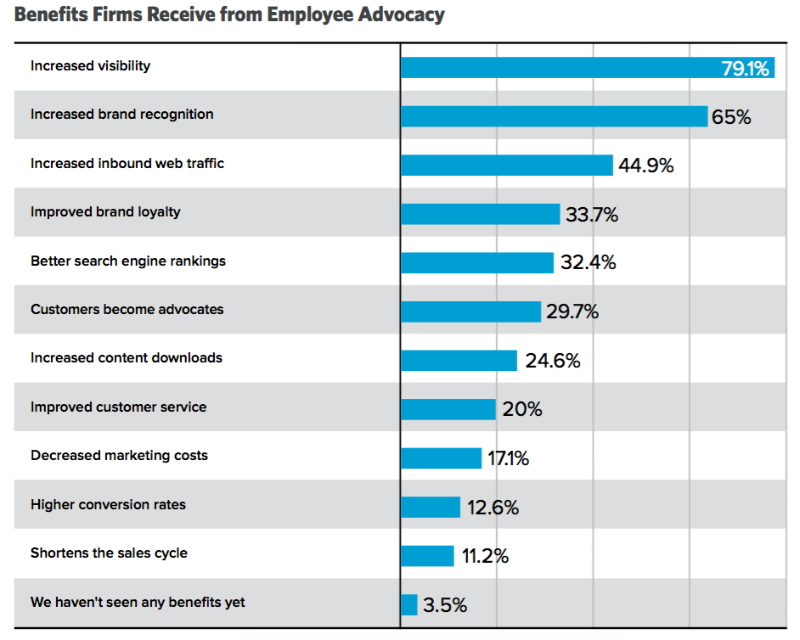Most places I’ve ever worked have no real idea what ’employee advocacy’ even is, so maybe we should begin there. It basically refers to the promotion of an organization’s brand by its employees, potentially (largely) on social media. This allows new people (their friends and connections) to understand what the brand is and how the brand may benefit them someday. There are a number of potential benefits to employee advocacy depending on what surveys and research you scroll through, such as this chart:

Probably the most important thing for most senior leaders at any organization is having some type of revenue plan around any new concept or initiative, and there are also paths to revenue through employee advocacy.
If this all seems somewhat intriguing, it is — or rather, it could be, but you need to have a vague idea of what you’re doing. Let me give you a quick example.
The last place I worked was a travel consortium. It’s a great company in terms of people going to events — there are dozens each year to allow bookers of travel (advisors/agents) to network with suppliers of travel (hotel/cruise/tour sales and managers). There isn’t a massive amount of turnover on the luxury side of the travel industry, so often people have been attending these events for 10 years or more, and some of their partners on the other side are legitimately good friends of theirs. As you might expect, my Facebook feed blew up with pictures whenever one of these events was held — champagne glasses, fancy dresses, hugs, etc. That’s all awesome — but here’s the problem.
I understand why those people are hugging and drinking champagne because I was in the industry/vertical, but a ton of people who encounter that photo? They have no idea. And you know what? They might be a person who wants to book travel eventually. So … that’s a loss. Someone who could be a client sees a devoid-of-context photo and doesn’t become a client — but they could have become a client if they knew what was going on.
So maybe the first step in employee advocacy is … defining the brand and the value proposition for all employees?
Perhaps.
But in reality, you’re already one step ahead of yourself.
The actual first step in employee advocacy comes by way of this research:
In a 2014 American Psychological Association survey of more than 1,500 employees, 91 percent of employees who felt valued said they were motivated to do their best for their employer, compared to just 37 percent of employees who did not feel valued. Furthermore, 85 percent of valued employees said they’d recommend their workplace to others; only 15 percent of non-valued employees would.
Right.
Who’s going to speak up for or endorse your brand if they don’t feel valued by it?
The dirty little rub here is something a lot of companies don’t yet understand — you need to treat your employees as well as you treat your customers.
This is confusing to many tasks-focused leaders, because customers are tied to revenue, and that’s important. Employees are seen as interchangeable, because that’s the predominant talent mindset of the last 50 years.
If you want employee advocacy as an idea to work, though, you need to start with respecting and valuing your employees. Then the relationship moves from transactional — i.e. based on a paycheck — to potentially transformative, i.e. based on real human connection.
Unfortunately, many managers don’t respect their employees and aren’t sure exactly what motivates them — and without those concepts in place, it’s very hard for your employees to ‘advocate’ for you out in the broader world.
One simple solution — but again, hard for many managers to accept — is simply allowing employees to be more authentic versions of themselves, which will foster both employee engagement and employee advocacy. Again, though, it requires a shift in managerial mindset away from ‘daily tasks and targets’ and towards ‘the whole person as an employee.’
It’s completely ludicrous to define a series of processes around ‘our new employee advocacy program!’ unless you have this base-level of respect and value in place.
My name’s Ted Bauer; I blog here regularly and you can learn about hiring me for freelance and contract gigs as well. You can also subscribe to my newsletter.
Article by channel:
Everything you need to know about Digital Transformation
The best articles, news and events direct to your inbox
Read more articles tagged: Featured






